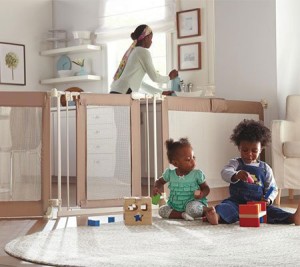
They start off as bundles of joy, but in no time they’ll be little rascals getting into every nook and cranny of your house. Here’s a crawl through the most used rooms and ways to make them safer. We say 'crawl’ because you should literally do this on your hands and knees, the best way to spot child safety hazards is to see your home from their point of view.
Start in the nursery
This is where they’ll spend the most time, so it’s important that it be as safe as possible.
Making sure the crib and furniture meet Health Canada’s safety guidelines is important, but even they require a bit of childproofing. For example, sturdy crib railings are a must but some kids like to chew them in the middle of the night, so a rail cover might be a good idea.
And those handles on the bottom shelf of your change table, as pretty as they are, should be covered so your baby doesn’t fall into them awkwardly if you’re playing on the floor.
Think about securing your furniture to the wall using safety brackets and/or straps so nothing tips over during carpet time.
If you’re considering a toy box, make it lidless so there’s no risk of anything slamming down on their heads or hands. It also gives your kid the freedom to get their own toys when they want them so you don’t have to get up.
You’ll also see outlets that need to be covered, drawers that need to be latched and doors that need to be stopped from slamming shut on little fingers.
Move to the bathroom
Child safety is tested in the bathroom. On your hands and knees, you’ll see a surprising number of sharp edges, tight spaces and other safety hazards in a bathroom. The first thing you want to do is prevent a child from getting into the bathroom unsupervised. You can place a doorknob cover over the knob or install a hook-and-eye latch high on the door.
In the bathroom, the toilet seat should always be left down (guys), and you should think about investing in a toilet lock to prevent your baby from lifting the lid and having it fall down on them as they're trying to climb in. Yes, it happens.
From your hands and knees, think about how high your baby will be able to reach, then make sure all your appliances, medications, vitamins, cosmetics and sharp items are stored higher than that. That goes for the bathtub as well. Get a showerhead basket to hold razors and shaving cream containers.
Speaking of the bathtub, make sure your mat is non-slip. And if your child does slip, a plastic or rubber guard over the tub spout will help prevent bumps and bruises.
Down to the family room
It’s the hub of activity in your house, so you'll want to make sure it's free from potential ouchies. On your knees, you’ll see how easy it is for a baby to pull down a potted plant or floor lamp, so make sure they’re out of reach, either on or behind furniture.
Fireplace safety is important in a family room whether yours is of the wood-burning or gas variety. Put a safety screen around the fireplace that your baby can’t get behind, but make sure it’s far enough away from the fireplace that it doesn’t get too hot.
Any tripping hazards such as throw rugs should be removed, and electrical cords should be stapled to the wall or baseboards. Corner cushions and edge guards tables will help keep your baby safe from head injuries as they move around.
And into the kitchen
On all fours, you’ll notice how dirty the floor is – which is to be expected as it’s probably the busiest room in your house. Babies and toddlers will put almost anything they find in their mouths, so a quick sweep a few times a day is never a bad idea.
Childproof locks are essential for kitchen drawers, cabinets, the stove, the dishwasher and the fridge (new parents tend to forget that last one until they come downstairs to find its contents emptied on to the floor). Knives should obviously be stored higher than where your baby can reach, but they’re not the only item to be cautious with. Seemingly harmless kitchen staples like toothpicks and bottle covers present choking and other hazards for your little one, so make sure they’re out of reach. And while your little one may not be able to reach the stovetop yet, it won’t be long. You may want to get a stovetop cover or stove knobs depending on whether your knobs are on the front of the stove.
Detergents, cleaning supplies, and other household chemicals should stay locked in a high cabinet, as should any heavy appliances like stand mixers and slow cookers. Garbage pails are easy to reach into and knock over. Keeping the lid closed is a good idea. So is keeping the dishwasher door closed so a running child doesn't trip over it or pull out something sharp.
Childproof your home sooner than later
It takes time to get used to living in a baby-proofed house. The earlier you can start, the more habitual it will be when your baby arrives.